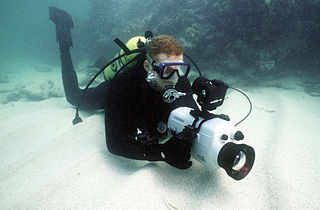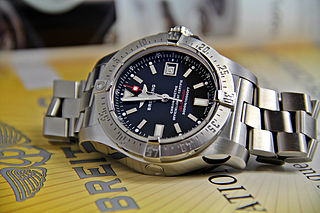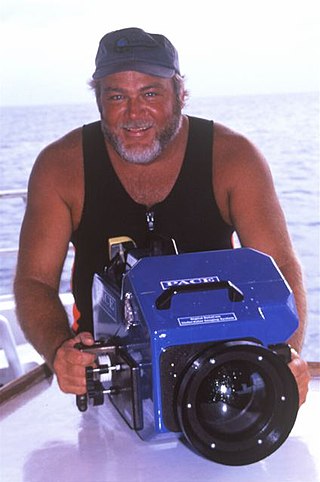The timeline of underwater diving technology is a chronological list of notable events in the history of the development of underwater diving equipment. With the partial exception of breath-hold diving, the development of underwater diving capacity, scope, and popularity, has been closely linked to available technology, and the physiological constraints of the underwater environment.

Underwater photography is the process of taking photographs while under water. It is usually done while scuba diving, but can be done while diving on surface supply, snorkeling, swimming, from a submersible or remotely operated underwater vehicle, or from automated cameras lowered from the surface.

Underwater videography is the branch of electronic underwater photography concerned with capturing underwater moving images as a recreational diving, scientific, commercial, documentary, or filmmaking activity.

A remotely operated vehicle (ROV) is a free-swimming submersible craft used to perform tasks such as valve operations, hydraulic functions and other general tasks within the subsea oil and gas industry. ROVs can also carry tooling packages for undertaking specific tasks such as pull-in and connection of flexible flowlines and umbilicals, and component replacement.

A submersible is an underwater vehicle which needs to be transported and supported by a larger watercraft or platform. This distinguishes submersibles from submarines, which are self-supporting and capable of prolonged independent operation at sea.

Hans Hass was an Austrian biologist and underwater diving pioneer. He was known mainly for being among the first scientists to popularise coral reefs, stingrays, octopuses, and sharks. He pioneered the making of documentaries filmed underwater and led the development of a type of rebreather. He is also known for his energon theory and his commitment to protecting the environment.

An atmospheric diving suit (ADS) is a small one-person articulated submersible which resembles a suit of armour, with elaborate pressure joints to allow articulation while maintaining an internal pressure of one atmosphere. An ADS can enable diving at depths of up to 700 metres (2,300 ft) for many hours by eliminating the majority of significant physiological dangers associated with deep diving. The occupant of an ADS does not need to decompress, and there is no need for special breathing gas mixtures, so there is little danger of decompression sickness or nitrogen narcosis when the ADS is functioning properly. An ADS can permit less skilled swimmers to complete deep dives, albeit at the expense of dexterity.

Lotte Hass was a pioneering Austrian diver, underwater photographer and model. She was nicknamed The First Lady of Diving. She was the first woman to dive in the Red Sea, the first woman to dive with autonomous diving equipment and the first underwater model. She was also the first person to take “in-water footage” of whale sharks and manta rays. She was married to Hans Hass, the Austrian biologist and fellow diving pioneer.
The International Scuba Diving Hall of Fame (ISDHF) is an annual event that recognizes those who have contributed to the success and growth of recreational scuba diving in dive travel, entertainment, art, equipment design and development, education, exploration and adventure. It was founded in 2000 by the Cayman Islands Ministry of Tourism. Currently, it exists virtually with plans for a physical facility to be built at a future time.

A diving watch, also commonly referred to as a diver's or dive watch, is a watch designed for underwater diving that features, as a minimum, a water resistance greater than 1.1 MPa (11 atm), the equivalent of 100 m (330 ft). The typical diver's watch will have a water resistance of around 200 to 300 m, though modern technology allows the creation of diving watches that can go much deeper. A true contemporary diver's watch is in accordance with the ISO 6425 standard, which defines test standards and features for watches suitable for diving with underwater breathing apparatus in depths of 100 m (330 ft) or more. Watches conforming to ISO 6425 are marked with the word DIVER'S to distinguish ISO 6425 conformant diving watches from watches that might not be suitable for actual scuba diving.

Bret Clifton Gilliam was an American pioneering technical diver. He was most famous as co-founder of the certification agency Technical Diving International along with Mitch Skaggs, and as the one time holder of the world record for deep diving on air. He is also one of diving's most popular writers. Gilliam is the author or coauthor of 72 books, over 1500 feature magazine articles, and over 100 magazine cover photos. In his diving career he has logged over 19,000 dives(NOT VERIFIED) since 1959.

Graham Hawkes is a London-born marine engineer and submarine designer. Through the 1980s and 1990s, Hawkes designed 70% of the crewed submersibles produced in those two decades. As late as 2007, he held the world solo dive record of 910 metres (2,990 ft) in the submarine Deep Rover.

René Théophile "Phil" Nuytten was a Canadian entrepreneur, deep-ocean explorer, scientist, inventor of the Newtsuit, and founder of Nuytco Research Ltd.
Joseph Beverly MacInnis D.Sc. is a Canadian physician, author, and diver. In 1974, MacInnis was the first scientist to dive in the near-freezing waters beneath the North Pole. In 1976 he became a member of the Order of Canada.
DOER Marine is a marine technology company established in 1992 by oceanographer Sylvia Earle, based in Alameda, California.
The Johnson Sea Link accident was a June 1973 incident that claimed the lives of two divers. During a seemingly routine dive off Key West, the submersible Johnson Sea Link was trapped for over 24 hours in the wreckage of the destroyer USS Fred T. Berry, which had been sunk to create an artificial reef. Although the submersible was eventually recovered by the rescue vessel A.B. Wood II, two of the four occupants died of carbon dioxide poisoning: 31-year-old Edwin Clayton Link and 51-year-old diver Albert Dennison Stover. The submersible's pilot, Archibald "Jock" Menzies, and ichthyologist Robert Meek survived. Over the next two years, Edwin Link designed an unmanned Cabled Observation and Rescue Device (CORD) that could free a trapped submersible.

The following outline is provided as an overview of and topical guide to underwater diving:

The following index is provided as an overview of and topical guide to underwater divers:

This is a list of underwater divers whose exploits have made them notable. Underwater divers are people who take part in underwater diving activities – Underwater diving is practiced as part of an occupation, or for recreation, where the practitioner submerges below the surface of the water or other liquid for a period which may range between seconds to order of a day at a time, either exposed to the ambient pressure or isolated by a pressure resistant suit, to interact with the underwater environment for pleasure, competitive sport, or as a means to reach a work site for profit or in the pursuit of knowledge, and may use no equipment at all, or a wide range of equipment which may include breathing apparatus, environmental protective clothing, aids to vision, communication, propulsion, maneuverability, buoyancy and safety equipment, and tools for the task at hand.













